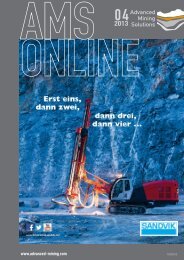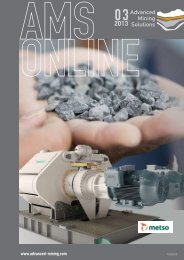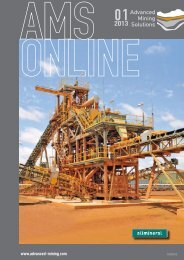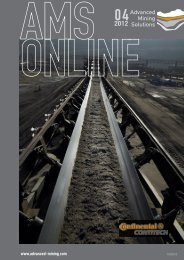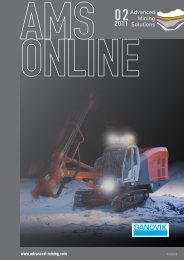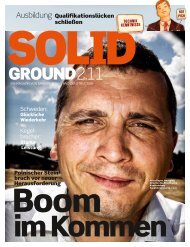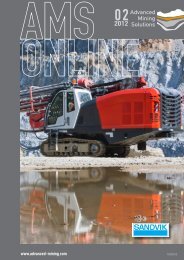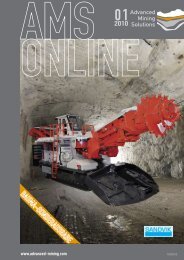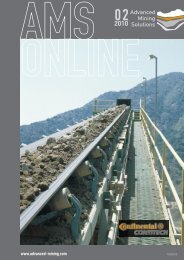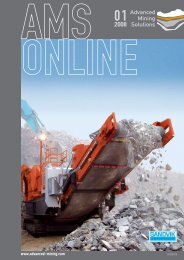A new face drilling rig for narrow tunnels and ... - Advanced Mining
A new face drilling rig for narrow tunnels and ... - Advanced Mining
A new face drilling rig for narrow tunnels and ... - Advanced Mining
You also want an ePaper? Increase the reach of your titles
YUMPU automatically turns print PDFs into web optimized ePapers that Google loves.
Terms of Trade<br />
The three biggest producers of hard coal in 2008 were<br />
China (with a global share of 45.8%), followed by the USA<br />
(17.2%) <strong>and</strong> India (8.5%). While China <strong>and</strong> India extended<br />
their production by 7%, it increased only by 3% in the<br />
United States.<br />
With a total volume of 930 Mt., about 16% of the global<br />
hard coal production was actually traded. About 839 Mt.<br />
(90%) of the trading volume was h<strong>and</strong>led by ship [2].<br />
Australia dominated the export market with a total<br />
volume of 259.8 Mt. (28%) followed by Indonesia with<br />
202.6 Mt. (21.8%) <strong>and</strong> Russia with 97.9 Mt. (10.5%).<br />
The three largest importers of coal have been Japan,<br />
South Korea <strong>and</strong> Taiwan. In total volume these Asian<br />
countries together import 351.7 Mt. (37.8 %) followed by<br />
India with 59.8 Mt. (6.4%), Germany with 44 Mt. (4.7 %),<br />
Great Britain with 43.9 Mt. (4.7%) <strong>and</strong> China with 40.8 Mt.<br />
(4.4%).<br />
Environmental aspects<br />
If you compare coal with other non–re<strong>new</strong>able<br />
resources, it has the greatest geological availability.<br />
Besides other aspects, the deposits are less concentrated<br />
on certain regions <strong>and</strong> there<strong>for</strong>e the production is spread<br />
across many countries <strong>and</strong> companies. This ensures a<br />
cheap availability <strong>for</strong> decades <strong>and</strong> <strong>for</strong> that reason it is quite<br />
possible that there will be a continued strong dem<strong>and</strong> <strong>for</strong><br />
coal, especially <strong>for</strong> the Asian markets <strong>and</strong> even worldwide,<br />
as Fig. 1 shows.<br />
A frequently discussed issue at the moment are the<br />
emissions that occur during the combustion process.<br />
Meanwhile, many industrial installations like power plants<br />
<strong>and</strong> steelworks have modern filter techniques available<br />
that avoid the emission of combustion residues like sulphur<br />
dioxide <strong>and</strong> ash. There<strong>for</strong>e, modern coal-burning plants<br />
can reduce emissions <strong>and</strong> enhance energy efficiency. A<br />
remaining problem is that the emission of the greenhouse<br />
gas CO² can not be reduced so far <strong>and</strong> un<strong>for</strong>tunatelycoal<br />
is the fossil energy resource with the highest specific level<br />
of CO² emissions. Indeed there are experimental plants<br />
that can separate carbon dioxide from the flue gas <strong>and</strong><br />
liquefy it (Carbon Capture <strong>and</strong> Storage (CSS)) but on the<br />
one h<strong>and</strong>, the process runs at the expense of efficiency<br />
<strong>and</strong> on the other h<strong>and</strong>, the search <strong>for</strong> an adequate final<br />
storage solution is difficult <strong>and</strong> antagonizes the residents<br />
Issue 04 | 2010<br />
TRANSFER OF TECHNOLOGY<br />
nearby. Another problem concerning the power generation<br />
is the dimension of coal-burning plants. When futurologists<br />
describe a smart grid, they are discussing the designs of<br />
a network that consists of many different generators <strong>and</strong><br />
consumers, who supply each other according to their<br />
requirements. There<strong>for</strong>e it is essential that the generators<br />
in the network have a high flexibility <strong>and</strong> can reduce their<br />
output or can even be turned ofwhen windy weather<br />
increases the output of wind turbines.<br />
The circumstances mentioned above could create a<br />
lower dem<strong>and</strong> <strong>for</strong> coal in producing electricity than shown<br />
in Fig. 1, but at present it is difficult to imagine how the<br />
future energy dem<strong>and</strong> of the world can be met without<br />
coal.<br />
Research project<br />
Although there is less exploitation of resources in<br />
European coal mines, the industry consumption is not<br />
decreasing. Besides, there are a lot of ongoing projects<br />
planned <strong>for</strong> coal-burning power plants <strong>and</strong> the turnover of<br />
port operations that import coal has been increasing <strong>for</strong><br />
years. Against the background of rising energy costs <strong>and</strong><br />
<strong>for</strong> ecological reasons, the aspect of the specific energy<br />
consumption of ship-unloading equipment is becoming<br />
more important.<br />
Typical bulk unloading equipment<br />
For the h<strong>and</strong>ling of bulk materials like iron-ore or coal,<br />
there are two completely different kinds of technologies:<br />
the continuous <strong>and</strong> the discontinuous respectively grabtype<br />
way. Fig. 6 shows the different types of ship unloaders<br />
classified according to the established technology.<br />
For the bulk material coal, the following unloading<br />
equipment can be found at larger port operations:<br />
• Grab-Type Unloader<br />
• Vertical Screw<br />
•<br />
Bucket Elevator<br />
www.advanced-mining.com<br />
61



